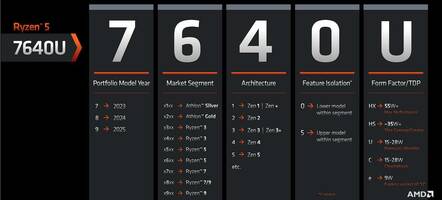This article is more than 1 year old
AMD admits its Ryzen mobile naming scheme is a mess, promises to clean it up
Finding Zen just got a little easier
AMD is changing the way it names mobile processors to make it more obvious whether you’re getting their freshest Zen cores or last year’s leftovers.
The chip designer’s mobile processors follow a familiar naming scheme, with the first two numbers referring to the chip’s generation and product family. The new naming scheme adds two new digits, AMD claims this will give clarity into features and performance as well as, critically for customers, reveals the underlying core architecture.
By this logic, an AMD 7640U would refer to a seventh-gen Ryzen 5, that uses a Zen 4 core, is a lower-end model, and has a TDP of between 15-28W. Confused? Here’s a quick breakdown courtesy of AMD:
“Our current naming system for Ryzen Mobile Processors was at an end. It simply could not accommodate the influx of new SOCs in new categories we’re developing,” AMD explained in a statement. “We wanted the system to be technical and informative, such that an enthusiast could quickly ‘decode’ the number to see what’s inside.”
The update underscores a longstanding problem with AMD’s naming conventions, which has often led to confusion where a customer could buy what they believed to be a current-gen chip, but discover later that it was based on an older Zen architecture.
For example, while the majority of Ryzen 5000 processors have AMD’s Zen 3 architecture, several of AMD’s mobile processors utilized older Zen 2 cores. Making matters worse, higher product numbers didn’t always guarantee the most modern process node. For example, AMD’s 5300U and Ryzen 5500U were saddled with a Zen 2 core, but the Ryzen 5400U and 5600U got newer Zen 3 cores.
- AMD refreshes desktop CPUs with 5nm Ryzen 7000s that can reach 5.7GHz with 16 cores
- AMD approaches '30%' x86 CPU market share, thanks to servers 'n' laptops
- US bars Nvidia and AMD from selling AI-centric accelerators to China and Russia
- Lenovo updates ThinkPad mobile workstations with AMD variants
This was one of several problems AMD’s new naming scheme aims to address. “We wanted it to be simple for the average user, where a higher number simply connotes higher CPU performance,” AMD said in a statement.
Another notable change is AMD appears to be standardizing its entire mobile processor line up under the new convention. Previously, AMD has reserved a separate naming scheme for its bargain-basement Athlon Silver and Gold processor families.
The changes are slated to go into effect alongside the launch of AMD's Mendocino and Dragon Range processor families in 2023. However don't expect the new naming convention to come to AMD's Ryzen desktop processors.
"We are not planning changes to the general numbering system we've used on desktop since the AMD Ryzen 1000 Series. This will continue forward as you'd expect," AMD said.
AMD’s mobile processor line has soared in popularity in recent years, which the chipmaker claiming its mobile processor shipments are up 49 percent over the past two years.
In May, Mercury Research said AMD now controls 22.5 percent of the laptop market.
While AMD has yet to officially launch Ryzen 7000 mobile, if the company’s desktop processors are any indication, the chips should provide a notable bump in performance over the previous generation chips. ®

